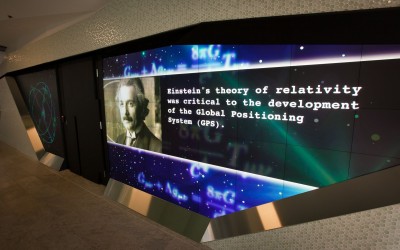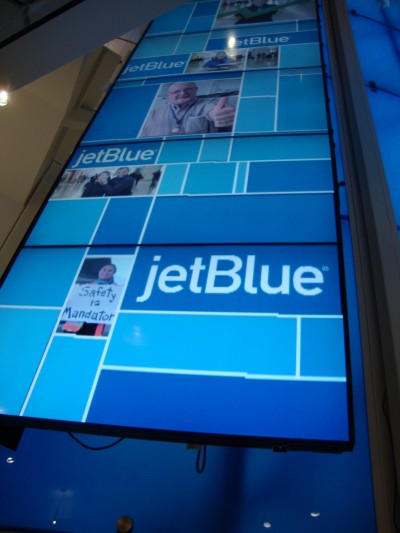
As more video walls go up, some installations are using unusual shapes. The lobby of the Stephen Hawking Centre at the Perimeter Institute for Theoretical Physics in Waterloo, Ont., features displays arranged in an irregular hexagon configuration. Photos courtesy Christie
Screen selection
Another important choice is which type of display to use, as there are many options today.
“It’s best to try to avoid relying just on the published specifications for different display technologies and instead compare them side-by-side,” says Richard Heslett, senior product manager at Christie, which manufactures digital projectors and other AV components and systems in Kitchener, Ont. “You can bring two or three alternatives into the intended space and look at how well they work there, given factors like lighting and viewing angles.”
Indeed, the nature of the location will significantly inform the choice of technology, from billboard-scale LED arrays and bright drive-thru menu boards outdoors to closer-proximity screens indoors.
“An LED wall is brilliant outside with a long viewing distance, but would appear quite pixelated and too bright indoors,” says Heslett. “So, the choices inside would include LCDs, plasmas and rear projection.”
It is also important to consider how the video wall will be used. Some are deployed for short-term promotional purposes, but others must run 24-7 for years on end, e.g. in airports. These applications call for ruggedized hardware that can resist dust and other pollutants, along with fans to keep the constantly running screens cool.
Such issues have raised the question of energy efficiency in recent years. LCDs carrying the Energy Star mark, for example, are offering features like ambient light sensors to adjust screen brightness automatically, real-time schedulers to turn off those displays that do not have to run 24-7 and, increasingly, more efficient backlighting.
“The industry is moving toward LED-backlit LCDs,” says Rachel Karnani, large-screen product manager for NEC. “By reducing power consumption, this can mean almost $5,000 in lifetime savings for a 3 x 3-screen wall.”
LEDs also eliminate the mercury and reduce the emitted heat associated with fluorescent backlighting.

JetBlue’s new headquarters (HQ) in New York, N.Y., features a pair of three-storey ‘wing walls.’ Each of these video walls comprises 14 liquid crystal displays (LCDs) in an 11-m (36-ft) tall stack. Photos courtesy Hiperwall
Creating content
New software is simplifying the process of producing content for video walls, whether that content is positioned on an individual screen, on multiple tiles or across the entire wall. These programs are designed to deal with extremely large images more quickly than conventional desktop graphic design and image rendering software can muster, but also provide many of the same image-enhancement options, such as mosaic effects and filters.
“Now you can reduce the time from concept to delivery of content to multiple displays,” says Greenberg, “and the cost is lower than the previous processor-based systems. It’s just running on ordinary computers with minimum requirements.”
Even easily created content may need to be specially configured to be consistent with the video wall’s configuration. A 14 x 1-m (46 x 3.3-ft) tower of screens, for example, will need content that works esthetically across its unusual display area. No matter the hardware, after all, the primary purpose of any video wall is to showcase its content.
“The technology may be the missile, but the content is the payload,” says Brawn.





